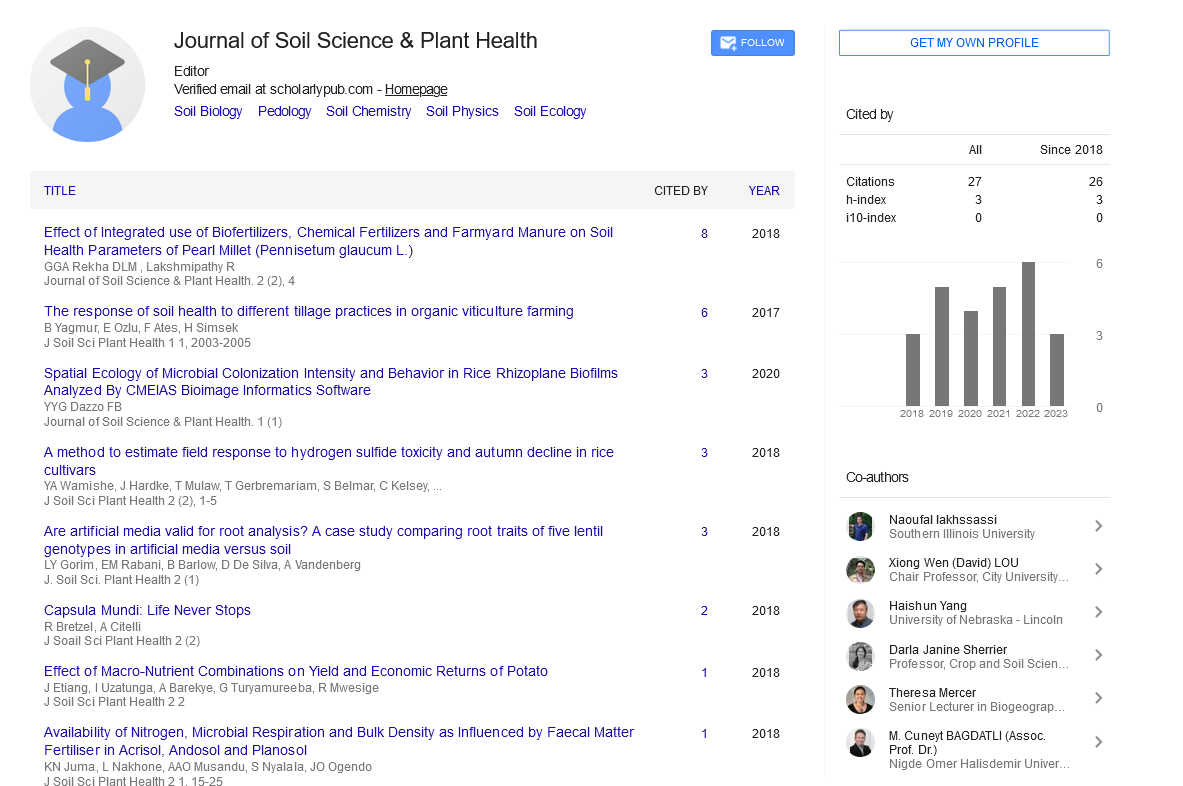Opinion Article, Vol: 7 Issue: 1
Plant Biosecurity-Natural Flora and Plant Products
Bernie Dominiak*
1Department of Pharmaceutical Chemistry, University of Dar es Salaam, Tanzania, United Republic of Tanzania
*Corresponding Author: Bernie Dominiak
Department of Pharmaceutical
Chemistry, University of Dar es Salaam, Tanzania , United Republic of
Tanzania
E-mail: bernie.@dpi.nsw.gov.au
Received date: 28 January, 2023, Manuscript No. JSPH-23-92783;
Editor assigned date: 30 January, 2023; PreQC No. JSPH-23-92783 (PQ);
Reviewed date: 14 February, 2023; QC No. JSPH-23-92783;
Revised date: 21 February, 2023; Manuscript No. JSPH-23-92783(R);
Published date: 28 February, 2023, DOI:10.4172/jsph.10000175
Citation: Dominiak B (2023) Plant Biosecurity-Natural Flora and Plant Products. J Soil Sci Plant Nutr 7:1.
Abstract
Plant biosecurity refers to the protection of plants from pests, diseases, and other harmful organisms that can cause significant damage to agricultural crops, natural ecosystems, and the environment. Plant biosecurity measures are essential to prevent the introduction and spread of invasive species that can cause significant economic and environmental harm. Plant biosecurity strategies include the use of physical, chemical, and biological methods to prevent, detect, and control plant pests and diseases.
Description
Plant biosecurity refers to the protection of plants from pests, diseases, and other harmful organisms that can cause significant damage to agricultural crops, natural ecosystems, and the environment. Plant biosecurity measures are essential to prevent the introduction and spread of invasive species that can cause significant economic and environmental harm. Plant biosecurity strategies include the use of physical, chemical, and biological methods to prevent, detect, and control plant pests and diseases.
These strategies can include measures such as quarantine, surveillance, pest risk assessments, and rapid response plans. Quarantine measures involve the inspection and treatment of plants and plant products before they are imported or exported to prevent the introduction or spread of pests and diseases. Surveillance and pest risk assessments involve monitoring plant populations and assessing the potential risk of pests and diseases, enabling early detection and response to outbreaks.
Rapid response plans involve quick action to contain and control the spread of pests and diseases once they are detected. Natural flora refers to the collection of microorganisms that live in a particular area, such as a forest, a river, or a desert. These microorganisms play an important role in maintaining the health of the ecosystem, as they are involved in processes such as nutrient cycling, decomposition, and even climate regulation.
Plant biosecurity also involves educating the public and stakeholders about the risks of introducing and spreading plant pests and diseases, as well as promoting best practices for preventing their introduction and spread. Overall, plant biosecurity is critical to safeguarding plant health, ensuring food security, and protecting the environment.
Natural flora refers to the collection of plant species that naturally occur in a particular region or ecosystem. These plant species play a crucial role in maintaining biodiversity and ecosystem functioning, providing habitat and food for various animal species and supporting important ecological processes such as nutrient cycling and soil formation.
It was generally refers to the collection of microorganisms that naturally live in and on the human body or in a particular environment. Plant products are the various products that can be derived from plants, including food, medicine, fibers, and industrial products. Many plant products have been used by humans for thousands of years, and they continue to be essential sources of livelihood and economic development in many regions of the world.
The use of natural flora and plant products can have significant environmental, social, and economic benefits. For example, the sustainable harvesting of plant products can provide income and employment opportunities for local communities, while also promoting the conservation of natural resources and biodiversity. The use of plant-based products can also help to reduce the environmental impacts associated with the production and use of synthetic materials, such as plastics and chemicals.
However, the unsustainable use of natural flora and plant products can lead to environmental degradation, loss of biodiversity, and negative social impacts. Therefore, it is important to promote sustainable practices for the use and management of natural flora and plant products, such as sustainable harvesting, cultivation, and processing techniques, as well as the promotion of biodiversity conservation and ecosystem restoration.
 Spanish
Spanish  Chinese
Chinese  Russian
Russian  German
German  French
French  Japanese
Japanese  Portuguese
Portuguese  Hindi
Hindi 